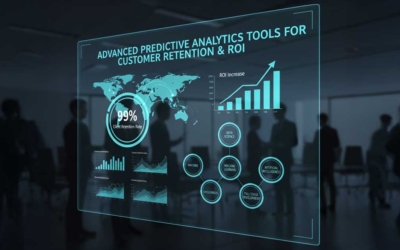Predictive analytics in supply chain management enhances demand forecasting, optimizes inventory, mitigates risks, and refines supplier performance. Companies can leverage data analytics to anticipate customer demands, reduce costs, and increase efficiency. This article delves into how predictive analytics transforms supply chains.
Key Points
- Predictive analytics significantly improves demand forecasting, reducing errors by up to 50% and increasing supply chain efficiency by 65%.
- Effective inventory management through predictive analytics leads to a 20% reduction in supply chain costs and a 10% increase in revenue by preventing stockouts and overstocking.
Improving demand forecasting with predictive analytics
Predictive analytics has become a cornerstone for enhancing demand forecasting, transforming how companies anticipate customer demands. Leveraging machine learning algorithms enables businesses to continuously refine their forecasts with new data, maintaining relevance and accuracy.
This technology allows companies to analyze historical data and real-time information, identifying hidden trends, patterns, and seasonality in customer demand. The integration of AI technologies significantly reduces forecasting errors by 20% to 50%, leading to reduced inventory costs and improved service levels.
The impact of predictive analytics on supply chain performance is profound. Accurate demand forecasting influences various aspects of the supply chain, including inventory costs, stockout levels, lead times, and transportation routes.
For example, companies like Walmart analyze data from millions of transactions and online searches to improve demand fulfillment and enhance shopping experiences. The ability to forecast demand accurately not only increases supply chain efficiency by 65% but also improves customer satisfaction by ensuring products are available when needed.
Predictive analytics enables companies to make timely and confident decisions by converting raw data into actionable insights. Natural language processing helps analyze unstructured data, such as social media, to gauge consumer sentiment and predict shifts in demand.
This approach allows businesses to anticipate demand fluctuations and adjust their strategies, leading to more accurate predictions and higher customer satisfaction.
Optimizing inventory management
Optimal inventory management is crucial for maintaining the delicate balance between supply and demand. Predictive analytics plays a pivotal role in this process by analyzing past customer behavior and future events to maintain optimal inventory levels.
This approach helps companies prevent both overstocking and stockouts, leading to significant cost reductions and improved resource allocation. For example, AI-driven predictive analytics can analyze demand patterns and reduce holding costs, ultimately improving inventory optimization.
The integration of predictive analytics allows companies to adjust inventory levels according to seasonal demand fluctuations, ensuring sufficient stock during peak periods. This capability is exemplified in Amazon’s anticipatory shipping practices, which predict customer demand to optimize inventory placements.
Combining historical data with real-time information helps organizations manage inventory more effectively, especially during critical periods. This proactive approach leads to a 20% reduction in supply chain costs and a 10% increase in revenue.
Proactive risk management in supply chains
Predictive analytics shifts supply chain operations from reactive to proactive, enabling companies to identify potential disruptions early and take preventive measures. This shift is crucial for managing risks in global supply chains, where unforeseen events can cause significant disruptions.
Employing risk assessment models allows companies to objectively quantify supplier risks and identify areas needing improvement. This data-driven approach enhances the accuracy of supplier performance forecasts by incorporating historical data and external factors.
The impact with suppliers
Supplier performance management is vital for supply chain efficiency. Predictive analytics identifies bottlenecks and quality issues, allowing for strengthening relationships with high-performing suppliers and addressing issues with underperforming ones. This data-driven approach facilitates better negotiations and informed decisions, improving overall supply chain performance.
Emerging technologies enhancing predictive analytics
Emerging technologies like artificial intelligence, machine learning, IoT, and blockchain are redefining predictive analytics in supply chains. These technologies enhance the accuracy and efficiency of predictive models, providing companies with valuable insights and competitive advantages.
The impact of AI and Machine Learning
Artificial intelligence (AI) and machine learning (ML) are revolutionizing predictive analytics in supply chains. By analyzing vast amounts of data, these technologies identify patterns and anomalies, enhancing prediction accuracy and enabling faster decisions.
ML algorithms continuously adjust models, which is especially useful in predictive maintenance for anticipating failures and increasing efficiency. The integration of AI and ML allows companies to anticipate problems and maintain smooth operations.
IoT integration for real-time data
The integration of the Internet of Things (IoT) with predictive analytics revolutionizes supply chains by providing real-time data. IoT devices offer visibility into shipment status, environmental conditions, and inventory, allowing for anticipating and mitigating problems, reducing costs and delays. Smart warehousing solutions automate inventory management, improving efficiency. The continuous flow of data updates predictive models, enabling timely decisions and enhancing supply chain resilience.
The role of blockchain in data integrity
Blockchain technology ensures data integrity and transparency in supply chains through an immutable ledger, enhancing traceability. This strengthens data integrity, supports robust predictive models, and builds trust among partners, fostering a collaborative and efficient supply chain, leading to reliable insights and better decision-making.
Predictive analytics, supply chain, and nearshore
In conclusion, implementing predictive analytics in supply chain management results in tangible improvements: reduced forecasting errors, optimized inventory, proactive risk management, and strengthened supplier relationships. Adopting emerging technologies like AI, ML, IoT, and blockchain further enhances these capabilities, enabling companies to anticipate market demands and operate more efficiently.
Nearshore facilitates the integration of these cutting-edge tools, allowing companies to not only optimize their supply chains but also compete in the global market with greater agility and resilience.
Frequently asked questions about predictive analytics
What is predictive analytics in supply chain management?
Predictive analytics in supply chain management leverages historical data and statistical algorithms to forecast future outcomes, enabling companies to better anticipate demand, optimize inventory, and manage risks effectively. This approach improves decision-making and operational efficiency.
Why does predictive analytics help companies save costs?
Predictive analytics reduces costs by optimizing inventory and improving demand forecasting, preventing overstocking and stockouts. It enables proactive risk management and optimizes supplier relationships, resulting in more efficient decisions and significant savings. Its implementation, facilitated by nearshore, boosts the competitiveness and resilience of supply chains.
What are the benefits of using predictive analytics for inventory management?
Using predictive analytics for inventory management optimizes inventory levels, reduces overstocking and stockouts, and decreases holding costs, ultimately improving supply chain efficiency and increasing customer satisfaction.
For companies looking to implement these advanced solutions, the nearshore model offers a strategic advantage by providing access to specialized and cost-effective tech talent. Collaborating with nearshore teams allows companies to effectively integrate predictive analytics into their operations, ensuring smooth implementation and maximizing return on investment.





0 Comments